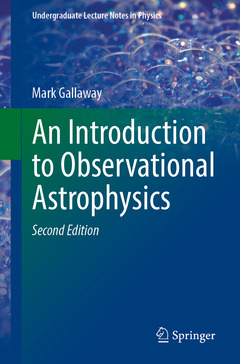Description
An Introduction to Observational Astrophysics (2nd Ed., 2nd ed. 2020)
Undergraduate Lecture Notes in Physics Series
Author: Gallaway Mark
Language: English
Subject for An Introduction to Observational Astrophysics:
Keywords
Astrometry Introduction; CCD Operation and Calibration; College Astrophysics Observing Projects; Filters Introduction; Guide for College Astrophysics; Imaging Introduction; Instrumentation for Observational Astrophysics; Photometry Introduction; Small Telescope Science; Spectrography Introduction
236 p. · 15.5x23.5 cm · Paperback
Description
/li>Contents
/li>Biography
/li>Comment
/li>
Dr. Mark Gallaway holds an undergraduate honors degree in Physical Science from the Open University and a PhD in Astrophysics from the University of Hertfordshire, UK (one of the largest astrophysics research groups in the UK). He has taught observational astrophysics at the University of Hertfordshire’s Bayfordbury Observatory (the largest such observatory in the UK and one of the largest robotic observatories in Europe) for three years, continuing to do so after he became the Observatory Manager in 2011.
During his current tenure Dr. Gallaway has overseen both a large increase in student numbers and a refocusing of the observatory to one of the UK’s leading small telescope research facilities. He is currently the PI of the Bayfordbury Supernova Search program, the Bayfordbury SuperWasp CV (Cataclysmic Variable) Follow-up program and the Bayfordbury NEO (Near Earth Object) Search. Dr. Gallaway is also a lead member of the M-Dwarf transit survey.
He regularly appears onthe BBC and other UK national broadcasters both as an expert. Furthermore, Dr. Gallaway has consulted on a number of general science programs in including the BBC documentary “How Satellites Rule Our Lives” and the series “How dangerous is….?”




